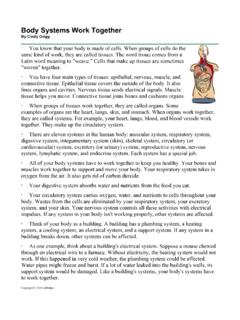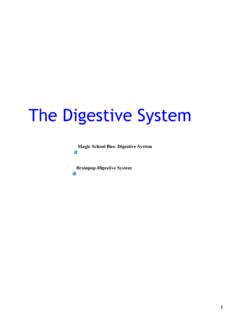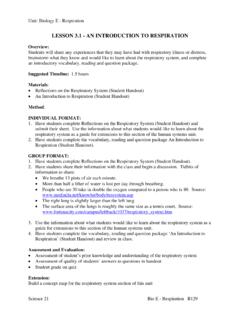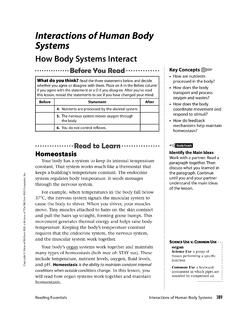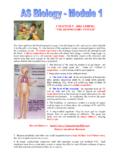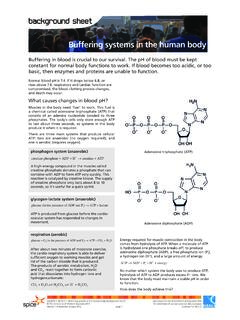Transcription of Air Around us W - NCERT
1 15 Air Around usWe have learnt in Chapter 9 thatall living things require , have you ever seen air?You might not have seen air, but, surelyyou must have felt its presence in somany ways. You notice it when theleaves of the trees rustle or the clotheshanging on a clothes-line sway. Pagesof an open book begin flutteringwhen the fan is switched on. The movingair makes it possible for you to fly yourkite. Do you remember Activity 3 inChapter 5 in which you separated thesand and sawdust by winnowing?Winnowing is more effective in movingair. You may have noticed that duringstorms the wind blows at a very highspeed.
2 It may even uproot trees and blowoff the you ever played with a firki(Fig. )?Move it a little, back andforth. Observe, what the firki rotate? What makes a firkirotate moving air, isn t it?Have you seen a weather cock(Fig. )? It shows the direction inwhich the air is moving at that Different types of firkiFig. Making a simple firkiFig. A weather cockActivity 1 Let us make a firki of our own, followingthe instructions shown in Fig. the stick of the firki and place itin different directions in an open AIR PRESENT EVERYWHEREAROUND US?Close your fist what do you have init? Nothing? Try the following activityto find 2 Take an empty open bottle.
3 Is it reallyempty or does it have something inside?Turn it, upside down. Is somethinginside it, now?2022-23148 SCIENCENow, dip the open mouth of the bottleinto the bucket filled with water asshown in Fig. Observe the water enter the bottle? Now tilt thebottle slightly. Does the water now enterthe bottle? Do you see bubbles comingout of the bottle or hear any bubblysound? Can you now guess what wasin the bottle?Yes! You are right. It is air , that waspresent in the bottle. The bottle was notempty at all. In fact, it was filledcompletely with air even when youturned it upside down. That is why younotice that water does not enter thebottle when it is pushed in an invertedposition, as there was no space for airto escape.
4 When the bottle was tilted,the air was able to come out in the formof bubbles, and water filled up the emptyspace that the air has activity shows that air occupiesspace. It fills all the space in the is present everywhere Around us. Airhas no colour and one can see throughit. It is earth is surrounded by a thinlayer of air. This layer extends up tomany kilometres above the surface ofthe earth and is called atmosphere. Aswe move higher in the atmosphere, theair gets Experiments with an empty bottleFig. Mountaineers carry oxygen cylinderswith themNow can you think, mountaineerscarry oxygen cylinders with them, whileclimbing high mountains (Fig.)
5 ? WHAT IS AIR MADE UP OF?Until the eighteenth century, peoplethought that air was just one have proved that it is reallynot so. Air is a mixture of many kind of a mixture is it? Let us findout about some of the majorcomponents of this mixture, one by vapourWe have learnt earlier that air containswater vapour. We also saw that, whenair comes in contact with a cool surface,it condenses and drops of water appearon the cooled surfaces. The presence ofwater vapour in air is important for thewater cycle in 3In the presence of your teacher, fix twosmall candles of the same length on a2022-23149 AIR Around UStable.
6 Light both the candles. Cover oneof the candles with an inverted glasstumbler. Observe both the both the candles continue to burnor go off?You must have observed that thecandle covered with glass tumbler gotextinguished after some time, whereasthe other candle continued can be the reason for this?Think about seems that the candle gotextinguished because the componentinside of the glass tumbler, whichsupports burning, is limited. Most of thecomponent is used up by the burningcandles. However, the other candle isgetting continued supply of air. Thiscomponent of air, which supportsburning, is known as Activity 3 did you observe that air isstill present in the glass bottle even afterthe candle blew out?
7 This indicates thepresence of some component in the air,which does not support burning. Themajor part of air (which does notsupport burning candle) is dioxideIn a closed room, if there is somematerial that is burning, you mayhave felt suffocation. This is due toexcess of carbon dioxide that may beaccumulating in the room, as theburning continues. Carbon dioxidemakes up a small component of the airaround us. Plants and animals consumeoxygen for respiration and producecarbon dioxide. Plant and animal matteralso consumes oxygen on burning andproduces mainly carbon dioxide and afew other gases.
8 It is advisable not toburn dry leaves and discarded remainsof the crop, which pollute and smokeThe burning of fuel also producessmoke. Smoke contains a few gases andfine dust particles and is often is why you see long chimneys infactories. This takes the harmful smokeand gases away from our noses, but,brings it closer to the birds flying up inthe sky!Dust particles are always presentin 4 Find a sunny room in your school/home. Close all the doors and windowswith curtains pulled down to make theFig. Air has oxygenFig. Air has oxygenCandleGlass tumbler2022-23150 SCIENCE room dark.
9 Now, open the door or awindow facing the sun, just a little, insuch a way that it allows sunlight toenter the room only through a carefully at the incoming beamof you see some tiny shiningparticles moving in the beam of sunlight(Fig. )? What are these particles?During winters you might haveobserved similar beam of sunlight filterthrough the trees in which dust particlesappear to dance merrily Around !This shows that air also containsdust particles. The presence of dustparticles in air varies from time to time,and from place to inhale air when we breathethrough our nostrils.
10 Fine hair andmucus are present inside the nose toPaheli wants to know, whythe transparent glass ofwindows, if not wiped offregularly, appears hazy?Fig. Observing presence of dust in air Policemen regulating traffic at a crowdedcrossing often wear a maskBoojho wants to know, whyduring an incident offire, one is advised towrap a woollen blanketover a burning is asking you, whydo you think, the policemanin Fig. is wearing amask?prevent dust particles from getting intothe respiratory you recall being scolded by yourparents when you breathe through yourmouth? If you do that, harmful dustparticles may enter your may conclude, then, that aircontains some gases, water vapour anddust particles.










